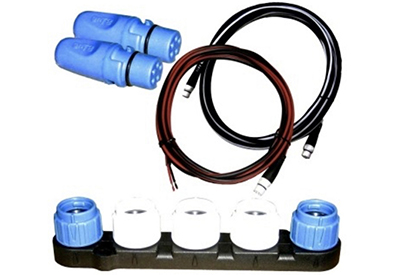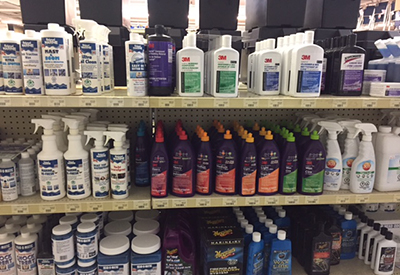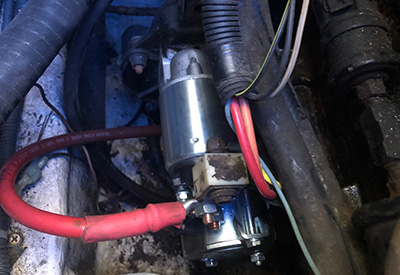Ask Andrew: Should I buy that boat? – from a mechanic’s viewpoint

May 9, 2019
An older engine, but with some upgrades (distributor cap, spark plug leads and hoses) that should be assessed further
This time of year, great deals abound. That boat with the ‘for sale’ sign looks quite attractive. The asking price is less than expected – the paint and varnish look great, with a bit of a polish and clean you can already feel the wind in your hair as you make way down the lake. The dream is perfect. But, there’s a caveat: The boat is being sold ‘as is’. You tell yourself ‘how bad can it be?’ as you reach for your chequebook…..
The problem lies in timing. Too often, the mechanic is called in after the purchase in order to ‘get it up and running’ – and the new owner has no sense of what was bought, or the costs associated with repair. Does this mean that you should only buy a boat that is in Bristol condition? Of course not. But, to save the headache and cost of arranging for a mechanic to review the boat before purchase, here are a few things you can look at first, before you sign the bill of sale.
 A nest of electrical wiring, with cut off ends, speaker wire used as electrical wiring, and a ‘clip on’ automotive style battery charger. Warning signs.
A nest of electrical wiring, with cut off ends, speaker wire used as electrical wiring, and a ‘clip on’ automotive style battery charger. Warning signs.
1) The engine oil will tell you a lot. The colour, quantity, and pressure will tell you how it was run and maintained before buying. If the oil is honey coloured and at the fill line on the dipstick, the engine is running well (or the oil was just changed – indicative of a previous owner who maintains the engine). Oil that is darker or black indicates that it hasn’t been changed regularly, and that the interior of the engine is dirty and could cause future problems. Oil pressure (read via a gauge at the helm, in most cases) tells a lot – pressure in range shows that the oil flows freely – if the engine oil is clean, but pressure is high, there may be obstructed oil passages or dirty oil. If the oil pressure is low, despite the level showing in range on the dipstick could indicate that the oil pump isn’t working at optimum range
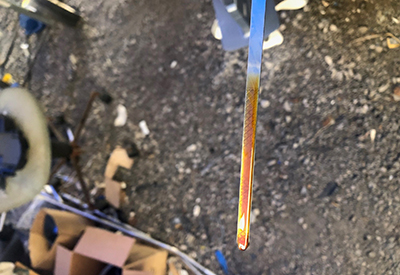 Oil colour and level is good – a positive sign that the engine has been maintained well.
Oil colour and level is good – a positive sign that the engine has been maintained well.
2) A Compression test is a test that is done to indicate that the pistons inside the cylinders are ‘squeezing’ air and fuel allowing it to ignite and run correctly. Low compression (below 90-100psi) in any of the cylinders can be indicative of a few different problems:
• Low compression in one cylinder only, could mean that there is a damaged piston head, cylinder wall, or piston rings
• Low compression in two adjacent cylinders could mean that the head gasket has been damaged and requires replacement
A compression test is a simple procedure requiring a compression tester (can be found in the auto section of any big-box store). The spark plugs are removed one at a time, and the compression tester threaded in place of the spark plug. The engine is turned over (key turned, but without firing the engine). Work through each cylinder and record results as you go.
120-125psi is ideal. If the compression is below 90 psi, that cylinder likely won’t fire and the engine may not run, as a result.
3) The propeller – check the wear and tear on the prop – a damaged or nicked prop may be very innocuous – but may also warrant more checks: check that the prop shaft still turns true, that the prop is tight and turns true, and that the gear oil (in case of a stern drive) is clean, with no debris.
4) The stuffing box is the ‘seal’ that surrounds the propeller shaft as it moves from inside the boat, into the surrounding water (in larger, inboard boats). The stuffing box is a tube that has a waxed rope wound inside of it – this rope naturally wears down as it contacts the spinning shaft, over time). It is natural for the stuffing box to leak – one drip per minute is the norm – any more, and this indicates that it needs tightening or re-packing
5) Corrosion – the amount of metallic wear, pitting and flaking on the engine block, external metal parts (prop, shaft, through-hulls, stern-drives, etc), and electrical connections can indicate many things: poor maintenance over time, extreme wear due to use in salt-water, galvanic corrosion, required replacement or addition of sacrificial anodes, required bonding or repairs to electrical equipment inside the boat
6) Electrical – keep your eye out for loose terminals on wiring, cut off or hanging wires, any burn marks or melted wire, exposed threads or loose connections.
7) Batteries – batteries should be wired appropriately, with clean terminals and connections, and should hold a minimum charge of 12V. If you have access to a load tester, this can be used to determine how well a battery holds its reserve capacity, as a load is applied to it.
8) Alternator – if the engine is operable, test to see if the alternator charges the battery: Test the battery before starting the engine, and test the battery again once the engine is running. The battery should read 12.6V with the engine off, and 13.5-14V, with the engine running
9) General wear and tear: hoses, clamps, oil/fuel spills, the debris in the engine bilge – will tell you a lot about maintenance leading up to this point, and potential future problems
9) Whenever possible, ask to go with the owner for a sea trial. Do an engine check before departing – checking battery state, engine fluids (oil, coolant, etc).
Before departing, check:
• the engine starts well (and also shuts off properly)
• the engine runs up to and maintains temperature
• that water runs in and out of the engine (through the exhaust) properly
• that the engine can rev to high RPM smoothly and doesn’t stutter or stall
• that the gears shift smoothly without stalling or ‘jumping’ into gear
• that bilge pump and blowers work correctly
While underway, check:
• that all gauges function correctly and give true readings
• that temperature is maintained
• that RPM matches boat speed (as RPM increases, so should boat speed)
• That all functions work correctly: battery switches, bilge pumps, trim/tilt, shifting, reving
• That the engine stops and re-starts correctly
• That fluids are checked after returning to dock, and are as expected
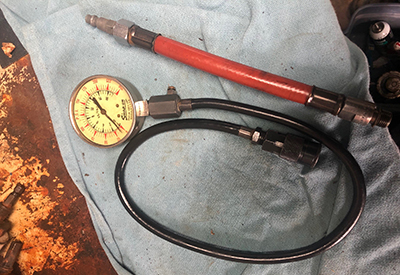 An example of a compression tester. The threaded end of the orange extension threads into the spark plug hole in the engine.
An example of a compression tester. The threaded end of the orange extension threads into the spark plug hole in the engine.
Buying a boat is an investment that could quickly become a money pit – hopefully this list will allow you to be aware of the potential costs associated with getting on the water quickly and seamlessly after purchase. Good luck getting back on the water this spring!
 Andrew McDonald is the owner of Lakeside Marine Services – a boat repair/maintenance firm based in Toronto. Andrew has worked in the marine industry for 12 years and is a graduate of the Georgian College ‘Mechanical Techniques – Marine Engine Mechanic’ program.
Andrew McDonald is the owner of Lakeside Marine Services – a boat repair/maintenance firm based in Toronto. Andrew has worked in the marine industry for 12 years and is a graduate of the Georgian College ‘Mechanical Techniques – Marine Engine Mechanic’ program.
Questions or comments for Andrew? Email him directly via: askandrew@lakesidemarineservices.ca



